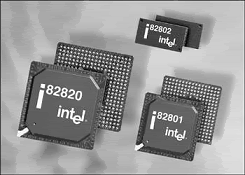Intel 820 and 820E Chipset
The Intel 820 chipsets use the hub-based architecture like all the 800 series chips and are designed to support slot 1 or socket 370 processors, such as the Pentium III and Celeron. The 820 chipset supports RDRAM memory technology, 133MHz system bus, and 4x AGP.

The 82820 MCH provides the processor, memory, and AGP interfaces. Two versions are available: One supports a single processor (82820), whereas the other supports two processors (82820DP). Either is designed to work with the same 82801 ICH as used with the other 800 series chipsets, such as the 810 and 840. The 820 chipset also uses the 82802 FWH for BIOS storage and for the Intel RNG.
The connection between the MCH and ICH uses what is called the Intel Hub Architecture bus instead of the PCI bus as with prior North/South Bridge chipsets. The hub architecture bus provides twice the bandwidth of PCI at 266MB per second, enabling twice as much data to flow between them.
The hub architecture bus also has optimized arbitration rules, allowing more functions to run concurrently, as well as far fewer signal pins, reducing the likelihood of encountering or generating noise and signal errors. The 820 chipset is designed to use RDRAM memory, which has a maximum throughput of up to 1.6GBps.
The 820 supports PC600, PC700, and PC800 RDRAM, delivering up to 1.6GBps of theoretical memory bandwidth in the PC800 version. PC800 RDRAM is a 400MHz bus running double-clocked and transferring 16 bits (2 bytes) at a time (2x400MHzx2 bytes = 1.6GBps). Two RIMM sockets are available to support up to 1GB of total system memory.
The AGP interface in the 820 enables graphics controllers to access main memory at AGP 4x speed, which is about 1GB per second—twice that of previous AGP 2x platforms. Because the 820 was designed for mid-range to higher-end systems, it does not include integrated graphics, relying instead on the AGP 4x slot to contain a graphics card.
820 Chipset features include
-
100/133MHz processor bus
-
Intel 266MBps hub interface
-
PC800 RDRAM RIMM memory support
-
AGP 4x support
-
ATA-100 (820E) or ATA-66 interface
-
Intel RNG
-
LPC interface
-
AC97 controller
-
One (820) or two (820E) USB buses with either two or four ports, respectively
The 820 chipset consists of three main components with a few optional extras. The main component is the 82820 (single-processor) or 82820DP (dual-processor) MCH, which is a 324 BGA chip. That is paired with an 82801 ICH, which is a 241 BGA chip, and finally it has the 82802 FWH, which is really just a fancy Flash ROM BIOS chip.
Optionally, there can be an 82380AB PCI-ISA bridge that is used only if the board is equipped with ISA slots. The newer 820E version uses an updated 82801BA ICH2, which supports ATA-100 and incorporates dual USB controllers with two ports each, for a total of four USB ports.
820 Chipset MTH Bug
The 820 chipset is designed to support RDRAM memory directly. However, because the market still demanded lower-cost SDRAM, Intel created an RDRAM-to-SDRAM translator chip called the Memory Translator Hub (MTH). This enabled them to produce 820 chipset motherboards that supported SDRAM instead of the more expensive RDRAM.
Because the design of the MTH was proven defective, the chip (and any board using it) was simply discontinued. On May 10, 2000, Intel officially announced that it would replace any motherboards using the MTH with a new board lacking the component.
The MTH translates signals from SDRAM memory to the Intel 820 chipset and is used only with motherboards utilizing SDRAM and the Intel 820 chipset; boards using RDRAM don't have an MTH and were not affected. Intel found electrical noise issues with the MTH that can cause some systems to intermittently reset, reboot, or hang.
n addition, the noise issue can, under extreme conditions, potentially cause data corruption. The MTH bug forced Intel to recall and replace more than a million motherboards in mid-2000, with new versions lacking the MTH and thus supporting only RDRAM memory.
The final bill for this recall was reported at about $253 million, making it perhaps the most costly recall of computer components since the infamous Pentium math bug in 1994. Intel has an MTH I.D. Utility at Intel that will tell you whether you have that component and whether your board is eligible for replacement, including a 128MB RDRAM RIMM.
Again, note that the 820 chipset was really designed to support RDRAM as the native type of memory, and RDRAM-based systems are not affected because they don't use the memory translator hub component.